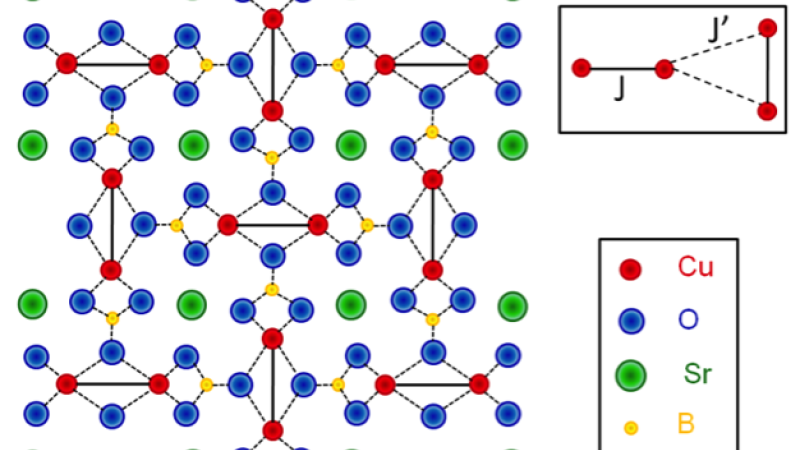The complex physics of interacting electron spin lattices in materials touches on a good portion of modern condensed matter physics, including the themes of quantum magnetism, quantum critical phenomena, and exotic states such as superconductivity.
The exotic compound SrCu2(BO3)2, or SCBO, was studied recently at the Spallation Neutrons and Pressure Diffractometer (SNAP) at Oak Ridge National Laboratory (ORNL). Sara Haravifard, a physicist at the University of Chicago and Argonne National Laboratory (ANL), is studying how SCBO transitions from one magnetic phase to another under extreme conditions: high pressure and low temperature.
This work is benefiting from the experimental resources of two user facilities: x-ray scattering at the ANL Advanced Photon Source and neutron scattering at the ORNL Spallation Neutron Source (SNS). The complementarity between the two techniques is well illustrated in this case, as the initial x-ray investigation hinted at two quantum phase transitions, one at a pressure of ~2 GPa and another at ~4 GPa. At this higher pressure, the researchers observed a change in the atomic lattice of the material that, given the strong spin-lattice coupling in the system, suggested the onset of an antiferromagnetic-ordered phase transition. Based on those results, the researchers decided to investigate this system using neutrons at SNS.
"Using neutrons at pressures higher than ~4 GPa was considered to be the next step in studying this new magnetic-ordered phase because, unlike x-rays, neutrons can detect magnetism directly," Haravifard said. SCBO, a quasi two-dimensional system, contains perpendicular copper dimers that carry magnetic spins lying on a square lattice and with only weak interactions between adjacent planes. This arrangement, known as the Shastry-Sutherland lattice, has a quantum mechanical ground state and excited states that can be solved exactly. SCBO is unique in that it is one of a few rare materials that realize this model.
"This system has this very exotic phenomenon—it can be pushed from a nonmagnetic state to an antiferromagnetic-ordered state by slightly changing where the atoms are sitting. Therefore, one can change the intensity of the coupling between copper ions by varying their bond distances," Haravifard said. "The ratio of the exchange couplings between the copper ions in SBCO lies just below the critical ratio believed to result in a quantum phase transition in the Shastry-Sutherland model. In other words, changing atomic positions results in different ground states. Therefore the application of hydrostatic pressure provides a clean mechanism to tune the bond lengths and thus change the exchange coupling ratio, inducing a quantum phase transition," Haravifard explained.
"So by applying high pressure to these quantum magnets, you can basically push them into these new states and then try to understand the system at the atomic level. You can use pressure as an unambiguous way to measure the formation of the ground state," Haravifard added.
To make this happen, SNAP plays a key role. "Not only do we have the capability to apply pressure at SNAP, but also we have neutrons. If the system is antiferromagnetically ordered—one electron spin up, one down—it forms a magnetic lattice that can be detected through the magnetic moments of neutrons. Additionally, neutron experiments typically require a rather large amount of sample, and SNS is one of the few places in the world where, because of its high neutron flux, it is possible to perform such an experiment despite the small amount of sample we can fit in a pressure cell," Haravifard said.
These types of studies give researchers a fundamental understanding of this complex system and an insight into whether the material could be made superconducting. Haravifard explained, "By tweaking this system under high pressure on SNAP, you might push it toward this desirable state. Theorists predict that if you tune it appropriately, if you replace some of the atoms with others and apply sufficient pressure, it has the potential to become a superconductor. This is important not only in helping us understand the most fundamental problems in physics but also because of its potential applications for industry," Haravifard said.
Haravifard is working on the project with a team of colleagues from the University of Chicago, ANL, ORNL, and McMaster University.—May 2013
SNS is operated and managed by the ORNL Neutron Sciences Directorate. Funding is provided by the Scientific User Facilities Division, Office of Basic Energy Sciences, US Department of Energy.
Published Related Work
S. Haravifard, A. Banerjee, J. C. Lang, G. Srajer, D. M. Silevitch, B. D. Gaulin, H. A. Dabkowska, and T. F. Rosenbaum, "Continuous and discontinuous quantum phase transitions in a model two-dimensional magnet," PNAS 109(7) 2286-2289 (2012), DOI: 10.1073/pnas.1114464109.



